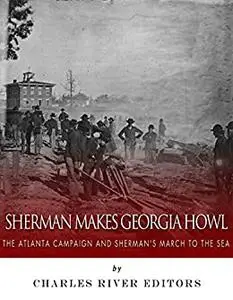Sherman Makes Georgia Howl: The Atlanta Campaign and Sherman’s March to the Sea by Charles River Editors
English | July 16, 2014 | ISBN: 1500534773 | 100 pages | EPUB | 1.65 Mb
English | July 16, 2014 | ISBN: 1500534773 | 100 pages | EPUB | 1.65 Mb
*Includes pictures of the battle's important generals.
*Includes several maps of the battle.
*Includes accounts of the fighting written by important generals.
*Includes a Bibliography for further reading.
After successfully breaking the Confederate siege at Chattanooga near the end of 1863, William Tecumseh Sherman united several Union armies in the Western theater for the Atlanta Campaign, forming one of the biggest armies in American history. After detaching troops for essential garrisons and minor operations, Sherman assembled his nearly 100,000 men and in May 1864 began his invasion of Georgia from Chattanooga, Tennessee, where his forces spanned a line roughly 500 miles wide.
Sherman set his sights on the Confederacy’s last major industrial city in the West and General Joseph E. Johnston’s Army of Tennessee, which aimed to protect it. Atlanta’s use to the Confederacy lay in its terminus for three major railroad lines that traveled across the South: the Georgia Railroad, Macon and Western, and the Western & Atlantic. U.S. Lieutenant General Ulysses S. Grant knew this, sending Major General William Tecumseh Sherman’s Division of the Mississippi towards Atlanta, with specific instructions, “get into the country as far as you can, inflicting all the damage you can against the war revenues.” The city’s ability to send supplies to Lee’s Army of Northern Virginia made Atlanta all the more important.
In August 1864, Sherman moved his forces west across Atlanta and then south of it, positioning his men to cut off Atlanta’s supply lines and railroads. When the Confederate attempts to stop the maneuvering failed, the writing was on the wall. On September 1, 1864, Hood and the Army of Tennessee evacuated Atlanta and torched everything of military value. On September 3, 1864, Sherman famously telegrammed Lincoln, “Atlanta is ours and fairly won.” Two months later, so was Lincoln’s reelection.
After the Atlanta campaign, Grant explained to Sherman that the Confederates must be “demoralized and left without hope,” and he instructed Sherman, “Take all provisions, forage and stock wanted for the use of your command. Such as cannot be consumed, destroy. Leave the valley so barren that crows flying over it…will have to carry their provender with them.” This strategy sought the total economic collapse of the South, as well as completely disabling the South’s capability of fielding armies. In addition to the wholesale plundering of Southern resources, including taking them from civilians, the Union reversed its policy of swapping prisoners, realizing it had a far bigger reserve of manpower than the South. The Atlanta Campaign was a perfect example of this, as both sides lost about the same number of casualties. By September 1864, however, Sherman still had about 80,000 men, while Hood’s army was reduced to about 30,000.
Thus, with his remaining forces, about 60,000 strong, Sherman decided to take the unprecedented step of cutting his own communication and supply lines and commencing a widespread march across Georgia, destroying Southern infrastructure and living off the land until his forces reached the coast and linked up with the Union navy. Aside from those plans, Sherman did not appoint a fixed time for his arrival, and the concept of the march greatly concerned the Lincoln Administration, since his men would virtually be on their own without any contact with the rest of the North as they marched straight through the heart of the Confederacy. Grant expressed his own concerns but eventually gave Sherman a simple go-ahead: "Go as you propose."
Ultimately, Sherman’s armies cut a path of abject destruction 60 miles wide and 300 hundred miles long from Atlanta to Savannah, which some likened to a Biblical blight. And as Sherman had intended, he did indeed made Georgia “howl.”
Feel Free to contact me for book requests, informations or feedbacks.
Without You And Your Support We Can’t Continue
Thanks For Buying Premium From My Links For Support
Without You And Your Support We Can’t Continue
Thanks For Buying Premium From My Links For Support



